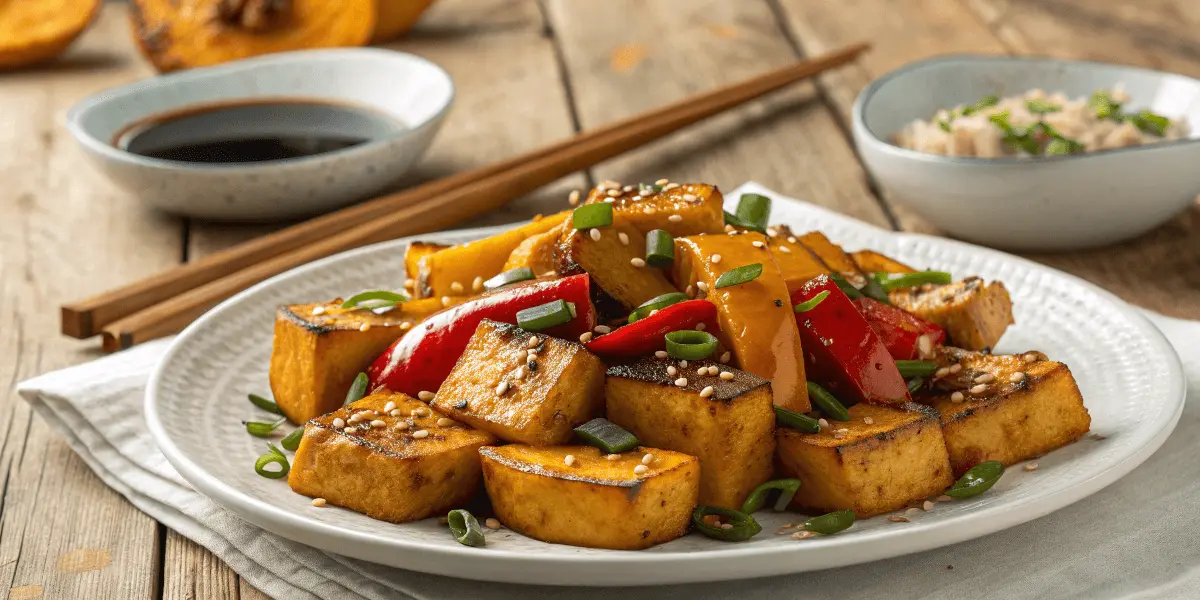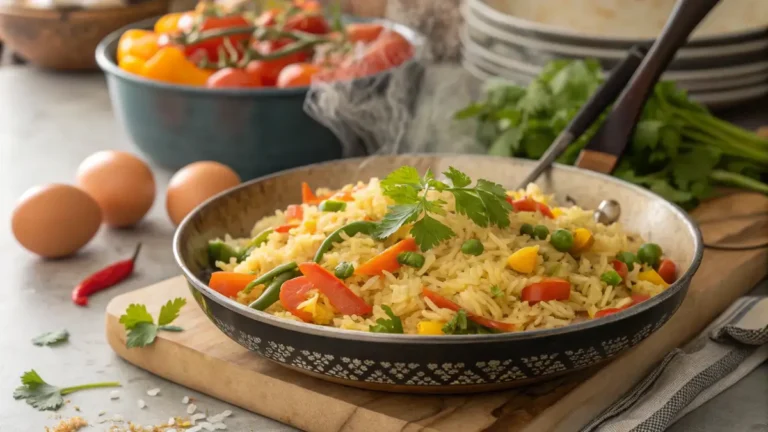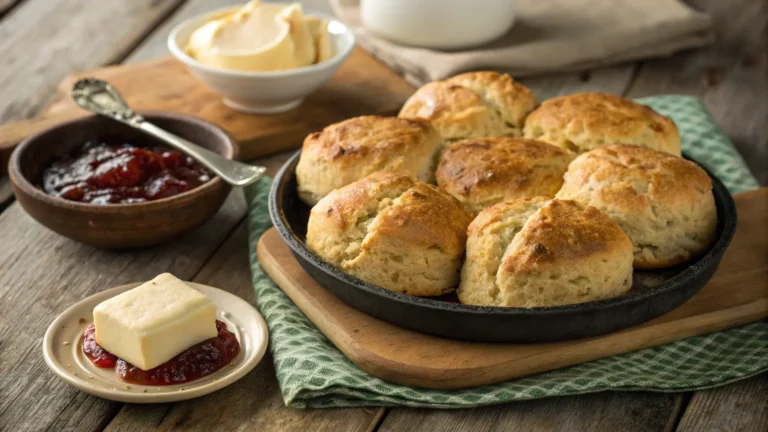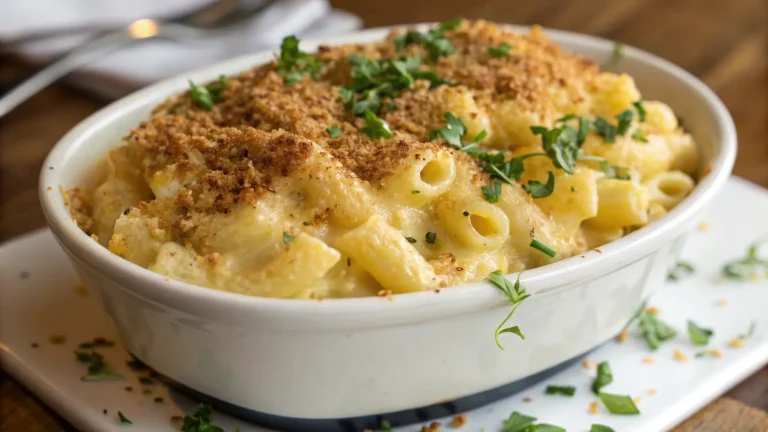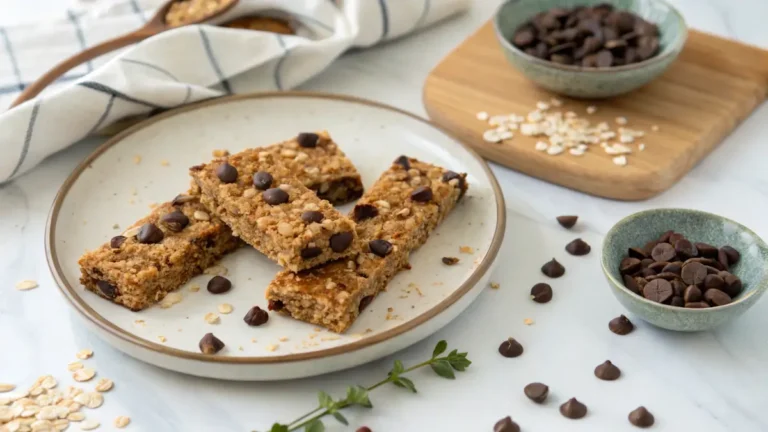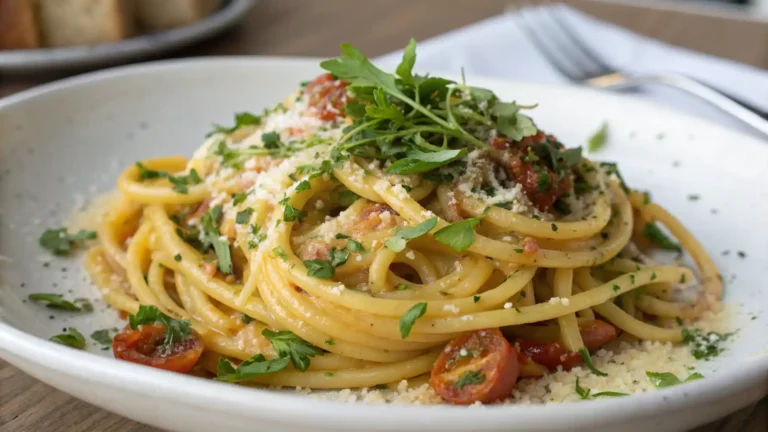How to Make Amazing Chinese Squash Recipes Kabocha Vegan
There’s something truly magical about kabocha squash—its naturally sweet, nutty flavor and velvety texture make it a staple in Chinese squash recipes. But have you ever tried it in a simple, plant-based dish that’s both rich and nutritious? Whether you’re craving a comforting stir-fry, a hearty roasted squash bowl, or a silky kabocha soup, this vegan-friendly recipe will elevate your meal with ease.
Packed with vitamins, fiber, and antioxidants, kabocha squash isn’t just delicious—it’s also incredibly nourishing. Plus, it pairs beautifully with fragrant ginger, garlic, and umami-rich seasonings, making it a perfect choice for an authentic yet easy-to-make Chinese-inspired dish.
So, if you’re looking for a wholesome, flavorful meal that’s as comforting as it is nutritious, this kabocha squash recipe is about to become a new favorite in your kitchen. Let’s dive in!
Table of Contents
Key Benefits of Vegan Chinese Kabocha Squash
A healthy and flavorful plant-based kabocha squash dish
Why should you try Vegan Chinese Kabocha Squash? Here are five compelling reasons that make these dishes a standout choice for your meals:
Nutrient-Packed Goodness
Kabocha squash is a nutritional powerhouse, rich in vitamins A and C, which support immune health and skin vitality. Incorporating it into your Vegan Chinese Kabocha Squash ensures you receive essential vitamins and minerals without compromising on flavor.
Heart-Healthy and Low-Calorie
These Vegan Chinese Kabocha Squash are naturally low-calorie, making them perfect for those mindful of their weight. Additionally, the high fiber content in kabocha squash promotes heart health by helping to lower cholesterol levels and maintain healthy blood pressure.
Versatile and Delicious
The savory and slightly sweet flavor of kabocha squash complements a variety of Chinese spices and ingredients. Whether you’re stir-frying, roasting, or steaming, Vegan Chinese Kabocha Squash offer endless possibilities to create mouthwatering vegan dishes that satisfy your taste buds.
Easy to Incorporate into a Plant-Based Lifestyle
Transitioning to a plant-based diet can be seamless with Vegan Chinese Kabocha Squash. They provide practical meal options that are both nutritious and delicious, helping you stay committed to your vegan lifestyle without sacrificing variety.
Rich in Antioxidants
Kabocha squash is loaded with antioxidants, which help combat free radicals in the body. Including antioxidant-rich foods in your Vegan Chinese Kabocha Squash supports overall health and can reduce the risk of chronic diseases, making these dishes not only tasty but also beneficial for your well-being.
Embracing Vegan Chinese Kabocha Squash means enjoying flavorful meals that are good for you and easy to prepare. Whether you’re a seasoned vegan or just exploring plant-based options, these dishes offer a delightful way to enhance your culinary repertoire.
Ingredients for Vegan Chinese Kabocha Squash
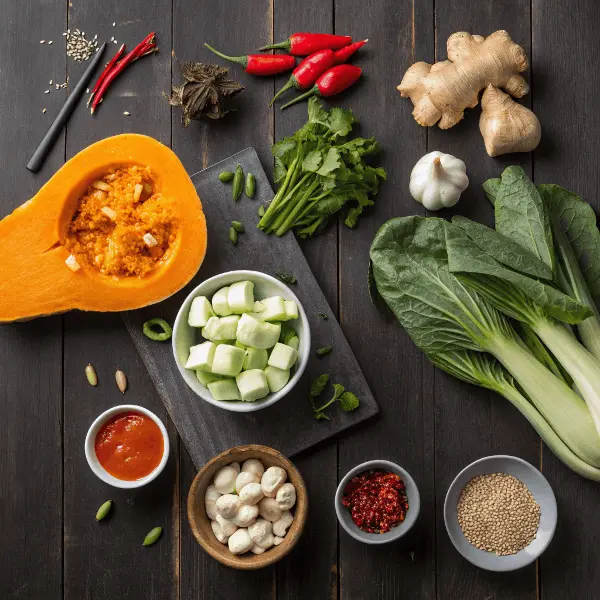
Here’s what you’ll need to make the perfect Vegan Chinese Kabocha Squash:
Main Ingredients
1 medium kabocha squash, peeled, seeded, and cubed
200g firm tofu or tempeh, pressed and cubed
2 tablespoons sesame oil
1 red bell pepper, sliced into thin strips
1 cup bok choy, chopped
3 cloves garlic, minced
1-inch piece of ginger, grated
Sauce Ingredients
3 tablespoons tamari (use gluten-free tamari for a gluten-free option)
2 tablespoons hoisin sauce (ensure it’s vegan-friendly)
1 tablespoon maple syrup or agave nectar
1 tablespoon rice vinegar
1 teaspoon cornstarch mixed with 2 tablespoons water (for thickening)
Spices and Seasonings
1 teaspoon five-spice powder
½ teaspoon chili flakes (adjust to taste for a spicy kick)
Salt and pepper, to taste
Optional Add-Ins
1 cup snap peas for added crunch
2 green onions, sliced for garnish
1 tablespoon sesame seeds for topping
Substitution Tips
Protein Alternatives: If you prefer, you can substitute tofu or tempeh with seitan or chickpeas for a different texture and protein boost.
Gluten-Free Options: Ensure all sauces, like tamari and hoisin, are labeled gluten-free. You can also use coconut aminos as a soy-free alternative.
Sweetener Alternatives: For those avoiding maple syrup, date syrup or brown rice syrup work well as natural sweeteners.
Vegetable Variations: Feel free to swap bok choy with spinach or kale if you prefer a different leafy green.
Pantry Staples
Rice or quinoa, cooked, for serving
Cooking utensils: A large wok or skillet, cutting board, and sharp knife
By preparing these ingredients ahead of time, you’ll streamline the cooking process and ensure a smooth, enjoyable experience as you create your delicious Vegan Chinese Kabocha Squash. Whether you’re a seasoned vegan or just exploring plant-based meals, these ingredients are versatile and easy to find, making your culinary adventure both fun and rewarding.
How to Make Vegan Chinese Kabocha Squash
Ready to create a delectable Vegan Chinese Kabocha Squash dish? Follow these simple steps to transform fresh ingredients into a mouthwatering meal that’s both nutritious and satisfying. Let’s get started!
1: Prepare the Kabocha Squash
Peel the kabocha squash, cut it in half, and scoop out the seeds. Cube the squash into 1-inch pieces for even cooking. Preheat the oven to 400°F (200°C), spread the cubed squash on a parchment-lined baking sheet, drizzle with 1 tablespoon of sesame oil, sprinkle with salt, and toss to coat. Roast for 25-30 minutes until tender and slightly caramelized to enhance the squash’s natural sweetness for your Vegan Chinese Kabocha Squash dish.
2: Prepare the Tofu or Tempeh
Press tofu to remove moisture by placing it between paper towels with a heavy object for 15 minutes, or steam tempeh for 10 minutes to soften it. Cut the pressed protein into bite-sized cubes for even crisping. Sauté the cubes in 1 tablespoon of sesame oil in a large wok or skillet over medium-high heat for 5-7 minutes until golden brown, then remove from the pan to add crunch and flavor to your Vegan Chinese Kabocha Squash dish.
3: Cook the Vegetables
Sauté Aromatics: In the same wok or skillet, add the remaining 1 tablespoon of sesame oil. Once heated, add minced garlic and grated ginger. Sauté for about 1-2 minutes until fragrant, being careful not to burn them.
Add Vegetables: Toss in the sliced red bell pepper and chopped bok choy. Stir-fry for 3-4 minutes until the vegetables are tender-crisp. If you opted for snap peas, add them now for an extra crunch.
Combine with Squash and Protein: Return the roasted kabocha squash and sautéed tofu or tempeh to the wok. Gently mix everything together, ensuring the ingredients are well combined.
4: Prepare the Sauce
Mix Sauce Ingredients: In a small bowl, whisk together tamari, hoisin sauce, maple syrup, rice vinegar, and the cornstarch slurry (1 teaspoon cornstarch mixed with 2 tablespoons water). This creates a rich, flavorful sauce that ties all the components together.
Add to the Wok: Pour the sauce over the vegetable and protein mixture in the wok. Stir well to coat all the ingredients evenly.
Thicken the Sauce: Allow the mixture to simmer for 2-3 minutes, stirring constantly, until the sauce thickens and becomes glossy. This step ensures that every bite of your Vegan Chinese Kabocha Squash is bursting with flavor.
5: Season and Garnish
Add Spices: Sprinkle in five-spice powder and chili flakes to taste. Adjust the seasoning with salt and pepper as needed. These spices add a warm, aromatic depth and a hint of heat to the dish.
Garnish: Remove from heat and garnish with sliced green onions and a sprinkle of sesame seeds. These finishing touches add freshness and a pleasant crunch to your Vegan Chinese Kabocha Squash creation.
6: Serve and Enjoy
Prepare the Base: Serve your Vegan Chinese Kabocha Squash over a bed of cooked rice or quinoa. The grains soak up the delicious sauce, making each bite satisfying.
Final Touches: For an extra burst of flavor, drizzle a little more tamari or a squeeze of lime juice over the top before serving.
Enjoy: Sit down, relax, and enjoy your homemade, wholesome vegan meal!
By following these steps, you’ll create a vibrant and flavorful Vegan Chinese Kabocha Squash dish that’s perfect for any meal. Whether you’re cooking for yourself or entertaining guests, this recipe is sure to impress with its rich flavors and satisfying textures. Happy cooking!
Pro Tips and Variations
Elevate your Vegan Chinese Kabocha Squash with these expert tips and creative variations. Whether you’re a seasoned vegan cook or just starting out, these suggestions will help you customize the dish to your taste and dietary preferences.
Pro Tips for Perfect Results
Choose a firm, heavy kabocha squash with a deep green color and no soft spots for sweetness and tenderness. Cut it into uniform 1-inch cubes for even roasting. Press tofu for at least 20 minutes to remove moisture for extra crispiness, and preheat your pan before adding oil for a golden-brown sear. Avoid overcrowding the pan to prevent steaming, and adjust sauce thickness by modifying cornstarch. Finally, taste and adjust seasonings to ensure a balanced meal.
Creative Variations to Try
Enhance your Vegan Chinese Kabocha Squash with a spicy kick from fresh chilies or sriracha, add a nutty crunch with crushed peanuts or cashews, and use tamari or coconut aminos for a gluten-free option. Boost protein by mixing in edamame or black beans, and elevate flavors with fresh cilantro or Thai basil. For a sweet and sour twist, add pineapple chunks or orange juice, and swap bok choy for spinach, kale, or Swiss chard for variety. Finally, serve over whole grains like brown rice, farro, or barley for added texture and nutrition.
Dietary Adaptations
Soy-Free Option: Replace tofu or tempeh with seitan or mushrooms for a delicious soy-free alternative.
Low-Sodium: Use reduced-sodium tamari and hoisin sauce to create a healthier, low-sodium version without compromising on flavor.
Sugar-Free: Substitute maple syrup with date syrup or omit the sweetener entirely if you prefer a less sweet dish.
By incorporating these pro tips and variations, you can customize your Vegan Chinese Kabocha Squash to perfectly match your taste preferences and dietary needs. Don’t be afraid to experiment and make this versatile dish your own!
Serving Suggestions
Transform your Vegan Chinese Kabocha Squash into a complete and satisfying meal with these delightful serving suggestions. Whether you’re preparing a quick weeknight dinner or hosting a cozy dinner party, these ideas will enhance the flavors and presentation of your dish.
Perfect Side Dishes
Pairing your Vegan Chinese Kabocha Squash with the right sides can elevate the entire meal. Consider these options to create a balanced and nutritious plate:
Steamed Brown Rice or Quinoa: These whole grains absorb the rich sauce beautifully, adding a hearty base to your meal.
Garlic Sautéed Greens: Spinach, kale, or bok choy sautéed with garlic provide a vibrant, nutrient-packed accompaniment.
Asian Slaw: A crunchy slaw made with shredded cabbage, carrots, and a tangy sesame dressing adds texture and freshness.
Garnishing for Extra Flavor and Appeal
Adding garnishes not only enhances the visual appeal of Vegan Chinese Kabocha Squash but also introduces additional layers of flavor:
Sesame Seeds: Sprinkle toasted sesame seeds over the top for a nutty crunch.
Fresh Herbs: Chopped cilantro or green onions add a burst of color and a fresh, aromatic touch.
Crushed Peanuts or Cashews: For an extra layer of texture, add a handful of crushed nuts.
Beverage Pairings
Complement your Vegan Chinese Kabocha Squash meal with beverages that enhance the savory and sweet notes of the kabocha squash dish:
Green Tea: A classic pairing that cleanses the palate and complements the umami flavors.
Herbal Infusions: Chamomile or jasmine tea offers a soothing contrast to the rich dish.
Sparkling Water with Lime: For a refreshing, non-alcoholic option, try sparkling water garnished with a slice of lime.
Presentation Tips
Creating an appealing presentation can make your Vegan Chinese Kabocha Squash feel special and inviting:
Color Contrast: Use a mix of vibrant vegetables and garnishes to create a visually stunning plate.
Plating Styles: Serve the kabocha squash in the center with sides arranged neatly around it, or opt for a family-style presentation where everyone can help themselves.
Layering Flavors: Arrange ingredients in layers to showcase the different textures and colors, making the dish as pleasing to the eyes as it is to the taste buds.
Additional Serving Ideas
Buddha Bowls: Create a nourishing Buddha bowl by combining your Vegan Chinese Kabocha Squash with a variety of vegetables, grains, and a drizzle of tahini or peanut sauce.
Stuffed Lettuce Wraps: Use large lettuce leaves to wrap portions of the squash and vegetables for a light and refreshing alternative.
Noodle Bowls: Add cooked rice noodles or soba noodles to your Vegan Chinese Kabocha Squash for a heartier meal that’s still light and flavorful.
By thoughtfully pairing and presenting your Vegan Chinese Kabocha Squash, you not only enhance the dining experience but also ensure a well-rounded and enjoyable meal. These serving suggestions are designed to complement the rich flavors and textures of your dish, making every bite a delightful adventure. Enjoy experimenting with these ideas to find your perfect combination!
Common Problems and Solutions
Even the most experienced cooks can encounter challenges when preparing Vegan Chinese Kabocha Squash. Don’t worry! Here are some common issues you might face, along with practical solutions to ensure your dish turns out perfectly every time.
Problem: Kabocha Squash Not Roasting Evenly
Solution:
Uniform Cubes: Make sure to cut the kabocha squash into uniform 1-inch cubes. This ensures that each piece cooks at the same rate, preventing some from being undercooked while others become too soft.
Single Layer Roasting: Spread the squash cubes in a single layer on the baking sheet. Overcrowding can lead to uneven roasting. If necessary, use two baking sheets to allow proper airflow around each piece.
Preheat the Oven: Always preheat your oven to the recommended temperature (400°F or 200°C) before roasting. A hot oven helps achieve a tender and caramelized exterior.
Problem: Tofu Not Getting Crispy
Solution:
Press Thoroughly: Ensure you press the tofu for at least 20 minutes to remove excess moisture. This step is crucial for achieving a crispy texture.
High Heat: Cook the tofu on medium-high heat and avoid moving it too frequently. Letting it sit undisturbed for a few minutes allows a golden-brown crust to form.
Use Cornstarch: Lightly coating the tofu cubes with cornstarch before sautéing can enhance crispiness and add a delightful crunch.
Problem: Sauce Too Thin or Too Thick
Solution:
Adjust Cornstarch Slurry: If your sauce is too thin, add a bit more cornstarch mixed with water and simmer until it reaches the desired consistency. For a sauce that’s too thick, simply add a splash of water or vegetable broth to thin it out.
Monitor Simmering Time: Stir the sauce continuously while it simmers to prevent it from becoming too thick. Remove it from heat once it reaches a glossy, thickened state.
Problem: Flavors Not Balanced
Solution:
Taste as You Go: Always taste your Vegan Chinese Kabocha Squash before serving. Adjust the seasoning by adding more tamari for saltiness, maple syrup for sweetness, or chili flakes for heat to achieve a balanced flavor profile.
Fresh Ingredients: Using fresh garlic and ginger can significantly enhance the overall taste. Avoid using overly strong or stale spices that might overpower the dish.
Problem: Vegetables Overcooked or Undercooked
Solution:
Timing is Key: Add vegetables like bell peppers and bok choy at the right time to maintain their texture. Bell peppers typically need 3-4 minutes of stir-frying, while bok choy should be added towards the end to retain its crunch.
High Heat Stir-Frying: Use high heat for quick cooking, which helps preserve the vibrant colors and crispness of the vegetables.
Problem: Ingredients Not Incorporating Well
Solution:
Proper Mixing: Ensure all ingredients are well-mixed when adding the sauce. Stir constantly to coat the vegetables and tofu evenly, allowing the flavors to meld together seamlessly.
Even Heat Distribution: Cook the dish on medium-high heat and stir frequently to prevent ingredients from sticking to the pan and to promote even distribution of flavors.
Problem: Lack of Depth in Flavor
Solution:
Layered Seasoning: Incorporate layers of seasoning by adding spices like five-spice powder and chili flakes at different stages of cooking. This builds a more complex and rich flavor profile.
Aromatic Ingredients: Don’t skip the garlic and ginger! These aromatics add a foundational depth to Vegan Chinese Kabocha Squash, enhancing the overall taste.
By anticipating these common problems and applying these solutions, you can confidently create a flawless Vegan Chinese Kabocha Squash dish. Remember, cooking is an art, and with each attempt, you’ll refine your techniques and elevate your culinary skills. Happy cooking!
Conclusion
Ready to transform your vegan meals with a delightful and nutritious twist? Vegan Chinese Kabocha Squashoffer the perfect blend of rich flavors and health benefits that are sure to become a staple in your culinary repertoire. Here’s a quick recap of why these dishes are a must-try:
Nutrient-Rich: Packed with vitamins A and C, fiber, and antioxidants, kabocha squash supports your overall health and well-being.
Versatile and Delicious: Whether you’re stir-frying, roasting, or steaming, Vegan Chinese Kabocha Squash adapt to your cooking style and taste preferences.
Easy to Prepare: With straightforward steps and accessible ingredients, you can create a wholesome meal without the hassle.
Customizable: From adding a spicy kick to incorporating different proteins, personalize the dish to suit your dietary needs and flavor desires.
Embracing Vegan Chinese Kabocha Squash not only enhances your meals but also supports a sustainable and plant-based lifestyle. Whether you’re a seasoned vegan or just beginning your plant-based journey, these recipes provide a delicious and satisfying way to enjoy the goodness of kabocha squash.
Ready to give it a try? Gather your ingredients, follow the easy steps, and savor the flavors of this amazing vegan dish. Don’t forget to share your culinary creations with us in the comments below or on your favorite social media platforms. We’d love to hear how your Vegan Chinese Kabocha Squash turned out and any creative twists you added!
Happy cooking and enjoy every bite of your healthy, flavorful meal!
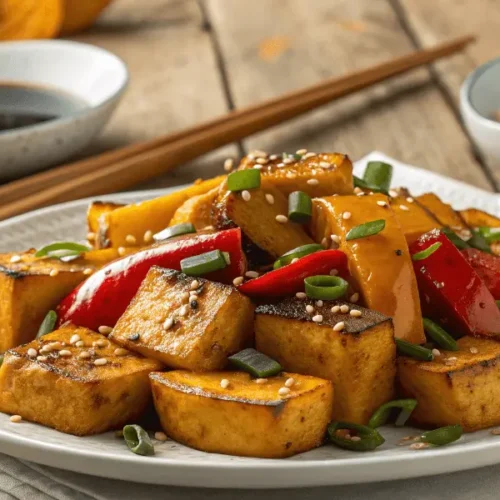
Vegan Chinese Kabocha Squash – Simple, Flavorful & Nutritious
Ingredients
Main Ingredients
- 1 medium kabocha squash peeled, seeded, and cubed
- 200 g firm tofu or tempeh pressed and cubed
- 2 tbsp sesame oil
- 1 red bell pepper thinly sliced
- 1 cup bok choy chopped
- 3 cloves garlic minced
- 1- inch piece ginger grated
Sauce Ingredients
- 3 tbsp tamari or gluten-free option
- 2 tbsp vegan hoisin sauce
- 1 tbsp maple syrup or agave nectar
- 1 tbsp rice vinegar
- 1 tsp cornstarch mixed with 2 tbsp water for thickening
Spices & Seasonings
- 1 tsp five-spice powder
- ½ tsp chili flakes adjust for spice level
- Salt & pepper to taste
Optional Add-Ins
- 1 cup snap peas for crunch
- 2 green onions sliced (for garnish)
- 1 tbsp sesame seeds for topping
Pantry Staples
- Cooked rice or quinoa for serving
- Large wok or skillet cutting board, sharp knife
Instructions
1️⃣ Prepare the Kabocha Squash
- Peel the kabocha squash, cut it in half, and scoop out the seeds.
- Cube the squash into 1-inch pieces for even cooking.
- Roast: Preheat the oven to 400°F (200°C). Spread the cubed squash on a parchment-lined baking sheet, drizzle with 1 tbsp sesame oil, sprinkle with salt, and toss to coat.
- Roast for 25-30 minutes until tender and slightly caramelized.
2️⃣ Prepare the Tofu or Tempeh
- Press tofu: Place tofu between paper towels with a heavy object for 15 minutes to remove moisture. (If using tempeh, steam it for 10 minutes to soften.)
- Cut into bite-sized cubes.
- Sauté: Heat 1 tbsp sesame oil in a wok over medium-high heat.
- Add tofu/tempeh cubes and cook for 5-7 minutes, turning until golden brown. Remove from the pan.
3️⃣ Cook the Vegetables
- Sauté Aromatics: In the same wok, add 1 tbsp sesame oil. Once heated, add garlic and ginger, and sauté for 1-2 minutes until fragrant.
- Add Vegetables: Toss in red bell pepper and bok choy. Stir-fry for 3-4 minutes until tender-crisp. (Add snap peas now if using.)
- Combine Ingredients: Return the roasted kabocha squash and sautéed tofu/tempeh to the wok. Gently mix everything together.
4️⃣ Prepare the Sauce
- Mix Sauce: In a small bowl, whisk together tamari, hoisin sauce, maple syrup, rice vinegar, and cornstarch slurry.
- Add to Wok: Pour the sauce over the stir-fry.
- Thicken: Simmer for 2-3 minutes, stirring constantly, until the sauce becomes thick and glossy.
5️⃣ Season & Garnish
- Sprinkle in five-spice powder, chili flakes, salt, and pepper.
- Adjust seasoning to taste.
- Garnish with green onions and sesame seeds.
6️⃣ Serve & Enjoy
- Serve over a bed of steamed rice or quinoa.
- For extra flavor, drizzle with tamari or a squeeze of lime juice.
Video
Notes
🌟 Pro Tips & Variations
Pro Tips for Perfect Results
✅ Choose a firm kabocha squash for best texture.✅ Press tofu for at least 20 minutes for extra crispiness.
✅ Preheat your pan before adding oil to get a perfect sear.
✅ Taste & adjust seasonings to balance flavors.
Creative Variations
🔥 Spicy Kick: Add fresh chilies or sriracha.🥜 Nutty Twist: Top with crushed peanuts or cashews.
🥬 Vegetable Swap: Use spinach, kale, or Swiss chard instead of bok choy.
🍍 Sweet & Sour: Add pineapple chunks or a splash of orange juice.
🍚 Serving Idea: Pair with brown rice, farro, or barley for added nutrition.
Dietary Adaptations
🌱 Soy-Free Option: Use mushrooms instead of tofu/tempeh.🧂 Low-Sodium: Use reduced-sodium tamari & hoisin sauce.
🍯 Sugar-Free: Swap maple syrup with date syrup or omit.
🍛 Serving Suggestions
Pair your Vegan Chinese Kabocha Squash with:🍜 Miso Soup for a warm, umami-rich starter.
🥗 Cucumber Salad with sesame dressing for freshness.
🍹 Ginger Tea or Jasmine Tea for a soothing beverage.
FAQs
Here are some common questions you might have about Vegan Chinese Kabocha Squash. Whether you’re a seasoned vegan or new to plant-based cooking, these answers will help you navigate and perfect your culinary journey.
Can I Freeze Vegan Chinese Kabocha Squash?
Yes! Freezing is a great way to preserve any leftovers or prepare meals in advance. Here’s how:
Cool Completely: Allow the dish to cool to room temperature before freezing.
Use Airtight Containers: Store in airtight containers or heavy-duty freezer bags to prevent freezer burn.
Label and Date: Clearly label each container with the date and contents.
Reheat Properly: When ready to eat, thaw in the refrigerator overnight and reheat on the stovetop or microwave until heated through.
Can I Substitute Kabocha Squash with Another Vegetable?
Absolutely! If kabocha squash isn’t available, you can use:
Butternut Squash: Similar sweetness and texture.
Sweet Potatoes: Offers a slightly different flavor but works well in the recipe.
Pumpkin: Another great alternative with a comparable taste profile.
These substitutes will maintain the dish’s hearty and nutritious qualities.
Is This Recipe Gluten-Free?
Yes, Vegan Chinese Kabocha Squash can be made gluten-free with a few adjustments:
Use Gluten-Free Tamari: Replace regular tamari with gluten-free tamari or coconut aminos.
Check Sauces: Ensure that all sauces, like hoisin, are labeled gluten-free.
By making these swaps, you can enjoy the dish without worrying about gluten content.
How Can I Make This Recipe Soy-Free?
For those avoiding soy, here are some alternatives:
Replace Tofu or Tempeh: Use seitan, mushrooms, or chickpeas as protein sources.
Choose Soy-Free Sauces: Opt for coconut aminos instead of tamari and ensure other sauces are soy-free.
These substitutions keep Vegan Chinese Kabocha Squash delicious and accessible for everyone.
What Can I Use Instead of Maple Syrup?
If you prefer not to use maple syrup, consider these natural sweeteners:
Agave Nectar: A vegan-friendly alternative with a mild flavor.
Date Syrup: Adds a rich sweetness and extra nutrients.
Brown Rice Syrup: Another great option that blends well with savory dishes.
These alternatives will maintain the recipe’s balanced sweetness.
How Do I Store Leftovers?
To keep your Vegan Chinese Kabocha Squash fresh:
Refrigerate: Store leftovers in an airtight container in the refrigerator for up to 4 days.
Freeze for Longer Storage: As mentioned, freezing is also an option for longer preservation.
Reheat Gently: Warm the dish on the stovetop or microwave, adding a splash of water if needed to restore the sauce’s consistency.
Can I Make This Recipe Spicier?
Definitely! If you love a bit of heat, try these tweaks:
Increase Chili Flakes: Add more chili flakes to the sauce or during cooking.
Add Fresh Chilies: Incorporate sliced fresh chilies or jalapeños for an extra kick.
Use Spicy Sauces: Drizzle some sriracha or chili garlic sauce over the finished dish.
These adjustments will amp up the spice level to suit your taste buds.
What Kind of Rice Pairs Best with This Dish?
While brown rice and quinoa are excellent choices, you can also try:
Jasmine Rice: Adds a fragrant aroma that complements the flavors.
Basmati Rice: Offers a light and fluffy texture.
Black Rice: Provides a striking color and nutty flavor.
Choose the rice that best fits your preference and enhances the meal’s overall appeal.
How Can I Make This Recipe More Protein-Rich?
To boost the protein content in Vegan Chinese Kabocha Squash:
Add More Tofu or Tempeh: Increase the amount of your chosen protein source.
Incorporate Legumes: Mix in lentils, edamame, or black beans.
Top with Nuts: Sprinkle with almonds, cashews, or peanuts for an added protein boost.
These additions make the dish more filling and nutritionally balanced.
Is This Recipe Suitable for Meal Prep?
Yes! This recipe is ideal for meal prepping:
Prepare in Batches: Cook a larger quantity and divide it into individual portions.
Store Properly: Use airtight containers to keep the meals fresh throughout the week.
Reheat with Care: Gently reheat on the stovetop or microwave, adding a little water if necessary to maintain moisture.
Meal prepping ensures you have delicious, healthy meals ready to go, saving you time during busy days.
We hope these FAQs help you create the perfect Vegan Chinese Kabocha Squash dish. If you have any other questions or tips to share, feel free to leave a comment below. Happy cooking!
